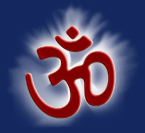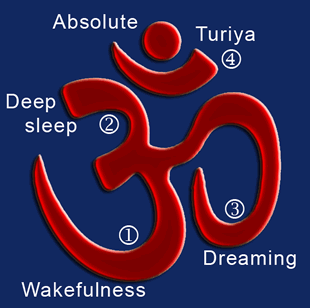Aum (Om)
Cosmic Intelligent Vibration, Cosmic Sound;
 The Sanskrit root word or seed-sound symbolizing that aspect of Godhead which creates and sustains all things; Cosmic Vibration. Aum of the Vedas became the sacred word Hum of the Tibetans; Amin of the Moslems; and Amen of the Egyptians, Greeks, Romans, Jews, and Christians. The world's great religions state that all created things originate in the cosmic vibratory energy of Aum or Amen, the Word or Holy Ghost. "In the beginning was the Word, and the Word was with God, and the Word was God... All things were made by him [the Word or Aum], and without him was not any thing made that was made" (John 1:1,3).
The Sanskrit root word or seed-sound symbolizing that aspect of Godhead which creates and sustains all things; Cosmic Vibration. Aum of the Vedas became the sacred word Hum of the Tibetans; Amin of the Moslems; and Amen of the Egyptians, Greeks, Romans, Jews, and Christians. The world's great religions state that all created things originate in the cosmic vibratory energy of Aum or Amen, the Word or Holy Ghost. "In the beginning was the Word, and the Word was with God, and the Word was God... All things were made by him [the Word or Aum], and without him was not any thing made that was made" (John 1:1,3).
![]() Paramahansa Yogananda chants AUM.
Paramahansa Yogananda chants AUM.
Amen in Hebrew means sure, faithful. "These things saith the Amen, the faithful and true witness, the beginning of the creation of God" (Revelation 3:14). Even as sound is produced by the vibration of a running motor, so the omnipresent sound of Aum faithfully testifies to the running of the "Cosmic Motor," which upholds all life and every particle of creation through vibratory energy. In the Self-Realization Fellowship Lessons (q.v.), Paramahansa Yogananda teaches techniques of meditation whose practice brings direct experience of God as Aum or Holy Ghost. That blissful communion with the invisible divine Power ("the Comforter, which is the Holy Ghost"—John 14:26) is the truly scientific basis of prayer.
![]()
Sage Patanjali, India's greatest exponent of yoga, describes God the Creator as Ishvara, the Cosmic Lord or Ruler. "His symbol is Pranava (the Holy Word or Sound, Aum). By prayerful, repeated chanting of Aum and meditation on its meaning, obstacles disappear and the consciousness turns inward (away from external sensory identification)" (Yoga Sutras I:27-29) (SC p.25)
![]()
AUM — The primordial, eternal divine sound heard in deep meditation; it represents the three bodies of every human being or the triple divine qualities — A is the causal body (sound), U is the astral body (vibration), and M is the physical body (light).
![]()
 The symbol of AUM consists of three curves (1, 2, and 3), one semicircle (4), and a dot.
The symbol of AUM consists of three curves (1, 2, and 3), one semicircle (4), and a dot.
The large lower curve 1 symbolizes the waking state (jagrat), in this state the consciousness is turned outwards through the gates of the senses. The larger size indicates that this is the most common and major state of the human consciousness.
Curve 2 denotes the state of deep sleep (sushupti) or the unconscious state. This is a state where the sleeper desires nothing nor beholds any dream. Curve 3 (which lies between deep sleep and the waking state) signifies the dream state (swapna). In this state the consciousness of the individual is turned inwards, and the dreaming self beholds an enthralling view of the world behind the lids of the eyes. These three curves therefore represent the entire physical phenomenon.
The dot signifies the fourth state of consciousness, known in Sanskrit as turiya. It signifies the coming to rest of all differentiated, relative existence This quiet, peaceful and blissful state is the ultimate goal of all spiritual activity. The semi circle (4) symbolizes maya and separates the dot from the other three curves. Thus it is the illusion of maya that prevents us from the realization of this highest state of bliss. The semi circle is open at the top, and does not touch the dot. This means that this highest state is not affected by maya. Maya only affects the manifested phenomenon. This effect is that of preventing the seeker from reaching his ultimate goal, the realization of the One, all-pervading, unmanifest, Absolute principle.
Further reading:
The Second Coming of Christ - Om (Aum)
The Bhagavad Gita (Chapter XVII:23)
The Bhagavad Gita (Chapter VI:14)
The Bhagavad Gita (Chapter X:33)
The Om Technique (SRF Convocation Notes)
![]()